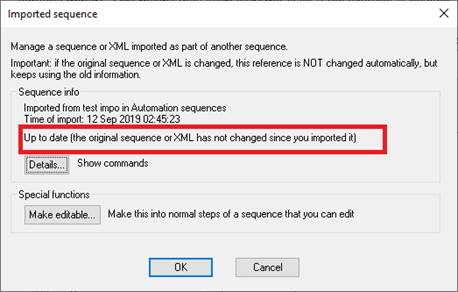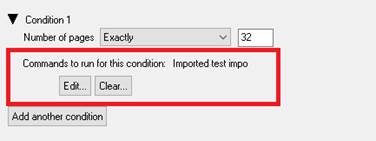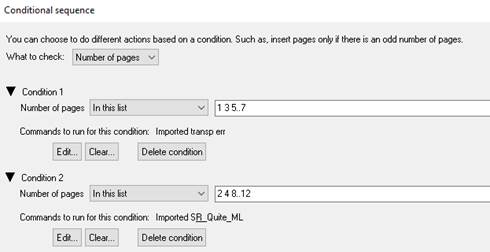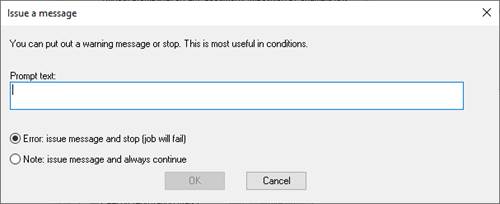Automation sequences are a new feature of Quite Imposing Plus 2.0. They are designed to allow you to
- Combine
several imposition commands into one, so an entire job can be done at once.
- Run
commands with or without prompting.
- Take
an existing PDF that you imposed and use it as a model for other impositions
(called "imposition by example")
- Arrange
your collections of command sequences and export them to share with other
people or move to other computers.
Quite Imposing Plus does not, however, provide any facilities to run sequences without intervention, or against a batch of files. Each file to be processed is handled separately.
Imposition by example
"Imposition by example" is a powerful way to use automation sequences in Quite Imposing. It makes use of another new feature of Quite Imposing 2.0: it saves details of all the commands you use, inside the PDF files you change or create.
You can look at these commands and all the options used with Imposition Info . But you can also use the commands directly with the automation sequences feature.
To create a new command sequence from the current document, click Import/Export and select the first option, Import commands from current document . You are now asked to give the sequence a name, and whether or not you want to see the command options each time.
Now you can use this command sequence again and again, each time taking a similar source and creating a similar result. Simply make sure the same sequence name is showing and click the Play button.
It is important to realise what is happening when you play back the sequence. The sequence is storing commands and options, not the exact layout of pages. This adds a lot of flexibility. For example, a sequence which numbers all the pages in a document, then makes a booklet of a particular size, will work no matter how many pages the document has, and no matter what size the pages are; it will process the numbering and booklet making as if you had run the commands and chosen the options again.
Some commands have limitations, which are noted in the section for that command. In addition you should generally avoid imposition options based on "current page", because it is hard to control what that means.
Creating a new sequence
To create a brand new sequence, you can just click the Create new sequence button. You will now see a screen with a list of commands on the left, and an empty box on the right. The idea is that you select commands in the left, and click Add to move them to the right. When you click Next , all the commands on the right make up your new sequence.
Normally, you just click a command name on the left, and you are prompted. For example, you can select Booklet and click Add (or double click Booklet ). You will be get five screens of choices for booklet making, exactly as if you had chosen to make a booklet from the Control Panel or menu. However, no booklet is made; you are just choosing options.
You have these choices to work with the list of sequences on the right hand side:
- You
can expand the commands by clicking the symbol to the left of the name. This
will show or hide all the command options.
- The
Remove button takes the command away. (It does not duplicate it on the
left, but you can still choose it from the left).
- The
Move up and Move down
buttons allow you to rearrange the list of commands.
- The
Edit button allows you to edit the options for your command. You can
also double click on the command.
When you are happy with your new command sequence, click Next . You will now get the chance to name the sequence and choose other options (which you can change later).
Working with Remember Last Action
If you prefer, you can use Remember Last Action which remembers the options used with the last time you ran a particular command. All these remembered actions will show up in the list of commands on the left hand side, and you can select them, then click Add .
These actions have the advantage that they move directly to the right hand side without prompting. You can still use Edit to change the options.
Options affecting playback
You have several choices available when you create or import a sequence. As well as giving the sequence a name, you can choose a user interface mode, and prompting options.
User interface mode controls how much interaction you have.
- Normal means the commands are run
exactly as normal. Each command shows its options, and when you click Finish
or OK the command is run. Then the next command shows its options, and
so forth. If you click cancel at any point, no further commands are run, but
the commands already used have had their effect.
- Fast means that you do not get to
see the prompting screens ("dialogs"). Typically
after a few seconds you just see the end results. You may get warning messages however.
- Advanced
batch mode
is similar to Fast but has some differences.
It will never create a new document, no matter what options were originally
chosen. It also does not issue messages as it goes, instead it collects them
all on the sequences screen at the end. This mode is similar
to that of a stand-alone product.
The Prompt choice allows you to create a new prompt to replace the ones you have chosen not to see. This can be used as a reminder or check. For example, the prompt might be "This creates the Friday edition. Did you remember the extra pages for the property section?". The user can click Cancel , and the sequence will not run.
New document choices
New document choices are available with many of the commands in Quite Imposing. In every case they are optional when you run a command, and so they are optional when you create a command sequence.
These are especially important when running a sequence in the default Fast mode. The effect of new document choices can be that a sequence with several commands makes several new documents, only one of which is interesting. You may wish to change the sequence so only the first command creates a new document.
Take care if you completely turn off new document creation. This means that imposed files will replace the original open document. You will normally want to be sure that you do not save this document, as it would destroy your copy of the original. This also applies to every sequence set up with Advanced batch mode.
Working with XML files
XML files are used by many programs, and have many different purposes. The best way to think of XML files is as containers for information. Quite Imposing can write XML files containing certain information, and can read back that information. It cannot read XML files written by other programs, or with different kinds of information.
XML files are popular for several reasons, including that they are easy to examine with a text editor. However, such advanced stuff is not necessary to work with XML.
An XML file can contain a sequence of Quite Imposing commands. This could have been created by using the Export function in Automation sequences. You can also import an XML file to create a new automation sequence, giving a simple way to share that sequence between computers.
Quite Imposing can also write XML files containing a whole collection of sequences, with their original names, and import the whole collection.
Import options
The following options are available on importing.
- Import
commands from current document, as discussed above under Imposition by example .
- Import
commands from another PDF document. You will be prompted to locate the document
(it need not be open). To find any commands, the file must have been processed
by Quite Imposing 2.0 or later.
- Import
commands from an XML file. This XML file might contain a single sequence of
commands, or a whole collection of sequences exported before.
Managing categories
The sequences control panel shows you both a category and a name for each sequence. Both are provided to help you organise your sequences. If you have only a few sequences, you need not create any new categories, you can just use the default, which is called "Automation sequences".
If you want to use more sequences, select Add new category from the list of categories. Any new sequence you create or import will be placed automatically in whatever category is currently shown.
Tips for working with categories:
- There
is no direct way to delete a category. However, if you delete the last sequence
from a category, you are offered the choice of whether or not
to delete the category.
- If
you make a mistake with a category name, you can add a sequence, then delete
it, to get rid of the category.
- To
move a single sequence between categories, export the sequence, then import it
again after choosing a different category.
- To
rename a category, export the whole category to an XML file, then create the
new category. Import the XML file; you will be told that the category name
exists, and you can choose the new category you just made. Finally, you can
delete all the sequences in the old category.
Your sequences are saved in the qiplusmemory.xml file, as described in Where are settings saved? .
Automation
sequences – Sequences Manager
(4.0)
The Remember last and
Playback functions have always been a convenient way to save a single command,
and play it back, showing all the choices but with the options filled in as
before. This has been much simpler than Automation Sequences, so some people
have kept using it. These functions can now work in two ways:
- Single action – as before, a single command,
which shows all its options when you playback.
- Whole job – this saves an automation sequence
from all the commands done in the current document. These sequences can be
edited in the Sequences control panel, and all sequences are available for use
in the streamlined Playback panel.
Version 4 includes a
Sequences Manager to assist in working with large numbers of sequences.
To run the manager click the Manage
button. Once open, the manager has a number of tabs:
- Manage – work with individual sequences
(e.g. rename, duplicate) and with entire categories.
- Files – work with the files used in
sequences and also background page size
definitions.
- Collect – collect
together all sequences and the files used, to take to another
system or for a backup.
- Report – generate reports on sequences.
- Backup – make backups of sequences.
Backups are also taken automatically.
- Restore – restore a backup, either merging
with current sequences or replacing them. You can also restore page
size/background definitions.
Sequences
Manager: Manage tab (4.0)
You can do the
following functions under Manage.
- Edit – edit a sequence (same as on the
main Sequences screen).
- Rename – rename a sequence. If the new
name already exists, you have the chance to replace it.
- Duplicate – duplicate a sequence, so you
can use a sequence as the starting point for a new one.
- Delete – delete a sequence.
- Copy to – copy a sequence to a different
category.
- Move – move a sequence to a different
category. It will be deleted from the current category.
- Delete category – delete entire category
and all of the sequences in it. Note that the
default category will be recreated, but the sequences in it will be gone.
- Duplicate category – make a new category
with copies of all of the sequences in it.
- Rename category – the new name must not
already be used for a category.
Sequences
Manager: Files tab (4.0)
You can set up
sequences and other things in Quite Imposing Plus which use files, that is,
external PDF files. The names of these files are stored. It can happen that
files need to be moved, or you lose track of which files are needed. The Files
section of the Sequences Manager helps you to work with these. Please see also
the Collect function.
Files may be used in
the following places:
- In a sequence which uses the Stick On PDF Pages command
- In a sequence which uses the Insert Pages command. This may insert blank pages, but it could also be inserting pages from a file.
- In a background used as a target “page
size” in sequences. For example, in N-Up as the background for a layout.
- In a named “page size” which is actually a background. These are not part of sequences,
but they are shown and you can manage them
anyway. Note that once a sequence is made using a named page size or
background, the file or size used is fixed; it will not change if the page
size definition is changed or deleted.
Files will show you a
list of the directories used. Within each directory, you see each file used. If
the file or directory no longer exists, this is also shown. Under each file you
see a list of the sequences and page sizes which refer to the file.
The following
functions are available. After any change the file list is updated.
- Edit sequence – available if a sequence is
selected in the display (under a file name). It allows you to edit or
review a single sequence which uses the file.
- Change directory – available if a
directory is selected. This label changes to Locate directory if the
directory is not found. In either case, you select a new directory, and all of the sequences and page sizes that use this
directory are updated. This does
not move any files, so you can easily break your sequences by picking
a directory without copies of the files. (If you break anything, see under
Restore).
- Open file – this is available when an
existing file is selected. It opens the file and closes the Sequences
Manager. You can use this to review the file contents.
- Change file – this is available when a
file is selected. If the file does not exist, the label changes to Locate
file. You will pick a single existing PDF file. All of
the sequences and page sizes that use this file are updated.
Sequences
Manager: Collect tab (4.0)
The collect function collects together all your sequences and files. A new
directory is made. In the directory will be copies of all of
the files used in every sequence and page size. A collect.xml file is written
which is a backup of all sequences. If the file names are not unique, some of
the files will be renamed by adding numbers.
This folder can be
backed up, or moved to another system. On the new
system use Restore and select “My collect”, which will import all the
sequences, updating the directory used in the sequences and page sizes to be
the new location.
You can also use this
method without changing system, if you have built up sequences and page sizes
that use files from an untidy collection of directories and you want them in
one place.
Sequences
Manager: Report tab (4.0)
You can generate TXT
file reports in the following formats:
- Short report – a list of all the sequences
and categories you have
- Long report – this gives all of the commands and options in every sequence and
category. This can be very long.
- File report – similar to
the information shown under the Files function, but in a printable text
format.
Sequences
Manager: Backup tab (4.0)
To avoid losing the
time spent setting up sequences, there are various automatic backups. You can
also do manual backups. Backups do not
include the files used in sequences, see the Collect function for that.
You can select
Automatic backup to make the same backups done automatically. Automatic backups
are stored in your user profile indefinitely. One is made before the first time sequences are changed on each day, and before a
restore. When you choose automatic backup, the file is written behind the
scenes, you do not choose a name.
You can select Choose
a file, and you will be prompted for a filename. This backup can be taken to
another system, but will not include the files used in
sequences. The backup will also include page size definitions.
Sequences
Manager: Restore tab (4.0)
Three types of restore
are available. In all cases you can choose Delete
all sequences first (full restore). If you do not choose this, your existing sequences are left, and you are
asked to confirm replacing each one.
If you do choose Delete all sequences first (full restore),
you can choose Also restore page size
definitions. This deletes all your existing page size and background
definitions, then restores from the backup.
- Restore from an automatic backup – shows
you a list of the automatic backups made, with date and time, most recent
first.
- My file – lets you select a backup file,
which will be an XML file.
- My collect – lets you select a directory
written by the Collect function, on this computer or a different one. The
directory will contain a collect.xml file and may contain PDF files. All
sequences restored will be updated, if they use files, to reflect the
directory in its current location. So do
not remove the directory after restoring.
Sequences:
filter sequence names (5.0)
When a user has many sequences or sequence categories, it can be time
consuming to find and select the one that is needed. Now, there is a space for
searching for a string.

Fill in a string and
click Go. You will see only:
- Sequences with a matching name, whatever category they are in.
- Categories with a matching name – you will see all sequences in a
matching category, whatever their name.
A sequence or category
matches if the string appears anywhere in the name. For instance
WED matches sequences called WED, WED.ITEM, WEDNESDAY,
STEWED. Click Show all to
go back and see everything.
Sequences:
Import sequences (5.0)
Importing sequences
(including importing from XML files) can save a lot of time in maintaining
sequences. Previously, users had to redo work in similar sequences. You can
import sequences in several places:
- The main sequence editor
- The new Conditions and Split/Merge commands

In all cases the
import sequences dialog appears.

You can import from an
XML file or another sequence. There are important differences between editable
and non-editable imports.
Editable
import (5.0)
When you import as
“editable” the steps of the original sequence are copied. There is no
connection to the original sequence, just the copies. If the original sequence
changes, there is no way to know this.
Non-editable
import (import reference)
(5.0)
When you import as a
reference, a copy is made of the original sequence steps, just as with editable
import. This means they keep working even if the original is deleted. They
will not change automatically even if the original is changed.
In a sequence, the
imported steps appear as if there is a command “Imported sequence”. If you
expand the list you will see where it was imported
from, and the commands included.

If you double click or
Click Edit, you can see further details and options.

If you click Make
editable, the steps of the imported commands are used instead of the
reference. You cannot undo this.
Notice that the
sequence is shown as “Up to date”. The original sequence has been compared. If
it has changed, you will have an Update button allowing you to read the
commands again so the reference is up to date.
Conditions in
automation sequences (5.0)
Essentially, a Condition command lets you run some tests and choose just one sequence to run. It is especially useful combined with Split/Merge (partials) to choose impositions that vary with the input page count.
Here are few of the
tests you can make
- Are there exactly 32 pages?
- Is the page count 1, 3 or 5 to 12?
- Are there more than 24 pages?
- Are any pages larger than US letter?
- Are all the pages exactly a4 size?
- Do any pages have bleed?
- Are any pages wide?
- Does the file name start FRIDAY?
- Is the document title (metadata) exactly BUSINESS CARDS?
- Does the document keywords (metadata) include RUSH?
We’re going to set up
an example of the first test (are there exactly 32 pages). If there are 32 pages we’re going to run a sequence called “Test Impo”. If there is not exactly 32 pages we’re going to stop
with an error.
This is the initial
dialog before we start. We need to make sure Number of pages is
selected.

Now we need to set up
a test (number of pages is exactly 32).

And we need to click Import.
(We might also click Create to start from scratch). We select the “Test impo” sequence.

We could click Add
another condition if we wanted more tests. In this case we do not.
We do want an error
message for the case where there is any other number of pages, so we move down
the dialog to the Otherwise section and click Message.

Now we choose a
message and select that it is an error. See the Message command, described
later. This Conditional command is now complete.
Some sequences allow
lists, to save duplication. Particularly useful is Number of pages … in this
list choice. This might set up different impositions according to the
number of pages, perhaps using Split and Merge (Partials) commands as needed.

You can list a range
of pages, so you can see 5..7, which means 5 to 7,
same as 5 6 7. You can also see 8..12 for 8 to 12. So the first condition applies if the number of pages is 1,
3, 5, 6 or 7. (Note: you cannot use commas, only spaces).
Note that only one
condition will be matched. Even if a later condition might also be matched,
this has no effect.
Sequences:
Message command (5.0)
The Message command
can be used in any automation sequence, though it is most useful with the new
Conditions command, as described above. Simply, it puts out a message. This may
be for information, or it may be an error message, stopping the sequence. (Your
choice).

In Quite Hot Imposing,
stopping the sequence causes the file to go to the ERROR folder.
The Message button in
Conditions is a shortcut for “create an automation sequence containing one
Message command”. The sequence created can be further edited to change the
message or add other commands.